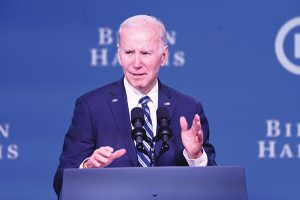Bloomberg
The US shot down an alleged Chinese surveillance balloon off the South Carolina coast on Saturday, injecting new tension into relations with Beijing which called the move an overreaction.
President Joe Biden said he ordered the Pentagon on Wednesday to down the balloon as soon as possible “without doing damage to anyone on the ground.†The military decided the best window was on Saturday while it was over the Atlantic within US territorial waters, capping days of waiting as it traversed the country.
China protested the US move and said it reserves the right to respond, according to a Foreign Ministry statement on Sunday. It said the US violated international practices after an accidental incursion of the balloon that was for civilian use.
China didn’t get advance notice of the plan to shoot down the balloon. US officials communicated to Beijing that they’d reserve the right to take such action, but didn’t follow up with more details about the plan once it was decided.
“They successfully took it down and I want to compliment our aviators who did it, and we’ll have more to report on this a little later,†Biden told reporters.
The balloon, along with another observed transiting Central and South America, had surveillance equipment not usually associated with standard meteorological activities or civilian research as claimed by China, a senior US administration official said on Saturday.
Its route over the US near many potentially sensitive sites also contradicted the Chinese government’s explanation that it’s a weather balloon, the official said.
News of the balloon entering US airspace led Secretary of State Antony Blinken to postpone a visit to China to meet with President Xi Jinping and prompted growing calls from Republicans, including former President Donald Trump, to shoot it down. On its way, the balloon passed over Montana, home to intercontinental ballistic missile silos.
Defense Secretary Lloyd Austin said China was using the balloon “in an attempt to surveil strategic sites in the continental United States†and the US plan to take it down involved “closely monitoring its path and intelligence collection activities.â€
Officials expect US-China relations to be difficult moving forward, but said that both countries have reasons to put the incident behind them. The second Chinese balloon spotted in Latin America that defense officials said was also conducting espionage activities is not a concern to the US, a person familiar with the matter said.
US officials expect to learn more about the balloon’s capabilities from a recovery operation under way off the coast, where US vessels are on site.
A single missile from an F-22 fighter jet brought down the balloon at 2:39 p.m. Eastern time, using the first available opportunity to bring it down without harming Americans, according to two senior officials who briefed reporters. The F-22 was flying at about 58,000 feet when it fired an Aim-9X Sidewinder missile at the balloon at between 60,000 and 65,000 feet, the officials said.
That followed an odyssey that took it into Alaskan airspace on Jan. 28, into a swing over Canada two days later and back over the US on Jan. 31. The overflight had intelligence value to the US by allowing officials to study and scrutinize the balloon and its equipment along the way, a defense official said. The US also took steps to mitigate the balloon’s intelligence gathering, the official said.
The military action shows that the administration is “responding effectively to the PRC’s unacceptable violation of our sovereignty,†Austin said in a statement, referring to the People’s Republic of China.
 The Gulf Time Newspaper One of the finest business newspapers in the UAE brought to you by our professional writers and editors.
The Gulf Time Newspaper One of the finest business newspapers in the UAE brought to you by our professional writers and editors.
